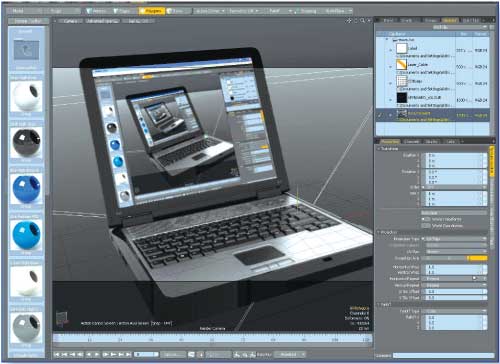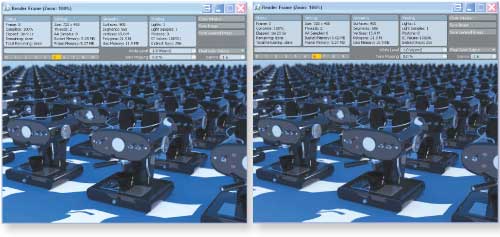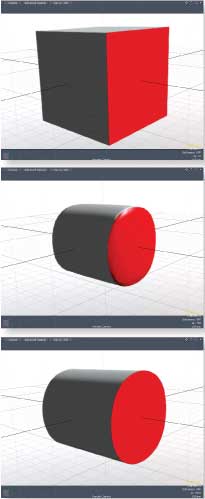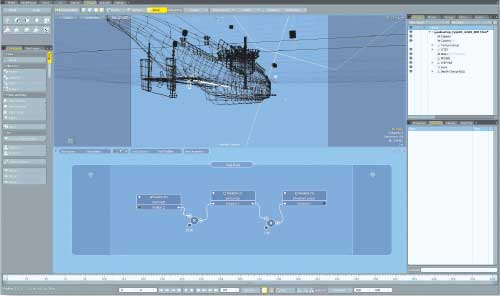Latest News
July 1, 2011
By Mark Clarkson
I reviewed modo 401 back in 2010. I liked what I saw then, and I like the new release even more.
The first thing I noticed upon firing up modo 501 was RayGL, modo’s new real-time render preview. Previous modo versions have had a dedicated preview window, but RayGL is better, faster and available in any window. With a few weird exceptions, RayGL gave me a fast, accurate preview of the finished render. This technology is becoming de rigueur in 3D applications, so it’s not surprising to see it here, but it’s still extremely welcome.
 The RayGL option, available in any modeling window, provides a fast, accurate preview of the finished render. |
Luxology claims to have greatly improved the rendering speed with version 501, and wow, have they ever. The first scene I tested—a 22 million polygon collection of espresso machines—rendered 2.25 times faster (189 seconds vs. 83 seconds).
Testing old scenes and new, I found 501 to consistently be much faster than 401, often two to three times faster. The results were often visibly superior, and typically used less memory than the same scene rendered in 401.
modo’s renderer is Intel single instruction, multiple data (SIMD) accelerated, so computers with modern cores (which, sadly, doesn’t include mine) will see an even bigger improvement in overall speed.
modo’s renderer offers better depth of field—complete with Bokeh effects, if you so desire. New bump map and displacement map engines provide better results with less memory.
 This array of 225 espresso machines, generated using modo’s Replicator feature, renders 2.25 times faster in modo 501, while using less memory. |
Calling Catmull and Clark
I use modo’s subdivision surfaces all the time. They turn boxy, low-resolution objects into smooth, high-resolution objects with a press of the tab button. While great for organic shapes, they’re a bit of a pain when it comes to hard-surface modeling. By their nature, sub-d surfaces smooth things out. So when it comes time to create some hard edges, you’re always fighting against them. You end up adding more geometry than you’d really prefer. To get a sharp corner, you typically have to slice the object up, adding new edges—and new rows of polygons—just to force the sub-d’s into a tighter bend. Tweaking the weights of your edges helps somewhat, but it also distorts your textures.
Enter Pixar subdivision surfaces—or more properly, Catmull-Clark subdivision surfaces. Pixar sub-d’s are very similar to modo’s native sub-d surfaces. In fact, at first the difference between them might not be at all apparent. The big benefit comes from the Pixar sub-d’s more useful brand of edge-weighting: You can get a nice, crisp edge by simply turning up that edge’s weight. (Pixar sub-d’s are also less prone to the distortion of UV textures, as they have less of a tendency to stretch and compress the underlying geometry around the edges.
 A simple 6 poly cube (top), converted to a tube with modo subdivision surfaces (middle) and the new Pixar subdivision surfaces (bottom). Pixar subdivision surfaces give crisper corners, with less distortion. |
Pixar sub-d’s also enable modo’s new multi-resolution mesh sculpting. This allows you to sculpt details at ever-higher levels of resolution without destroying the previous resolution.
Pixar sub-d’s are more computationally complex, and they do generate a higher density mesh (read: more polys) at any given subdivision level, so your computer works harder while you work less.
Schematics View
modo’s animation system, in addition to doing both forward and inverse kinematics, lets you hook up nearly anything to nearly anything else via constraints, linkages and relationships. You scale an object’s texture when that object is scaled, for example. But you can also change an object’s color when it’s scaled. Most applications are more prosaic: having windows open together, or one gear driving another.
On an animation I did of a submarine, for example, the screws are driven by a simple relationship with the sub’s position: for every X meters the sub moves forward, the screws revolves once on their axes. (As they are counter-rotating screws, one of them multiplies the sub’s position by -1.)
This works really well, but anything more complex becomes progressively more difficult to visualize and maintain. And modo is capable of nightmarishly complex assemblies “entire internal combustion engines, industrial robots, etc.
modo 501’s new schematic view takes a giant leap in the right direction. Now you can lay your relationships out in a very visual way, and a normal human being has a much better chance of being able to create, edit and use complex assemblies.
To recreate my submarine rig, I drag the submarine’s Z position—and each propeller’s Z rotation—onto the stage, where they appear as labeled boxes. I hook the boxes up by dragging from any box’s output to any other box’s input. Where math is needed, I drag a math operator onto the stage and hook it up. The results are easy to read, and easy to modify.
Even better, you can package these schematics up into assemblies. Assemblies not only keep things nice and neat, but also allow you to reuse your animation rigs, texture drivers and what-have-you by applying them to different objects.
It’s the Little Things
There are little improvements all around. You can now define the default snap, axis, brush and snap state for your tools. Sculpt tools work in the UV mapping workspace. modo’s fur—with new frizz and kink settings—is also easier to comb. modo reads RGB-alpha images directly, giving you alpha and color channel in one file. You can also work with really huge image maps.
modo 501 comes with a whole new set of procedural textures, with everything from dripping water to spaceship panels to the extremely useful occlusion shader. The occlusion shader lets you isolate low or high areas of your geometry—areas that would be shadowed or would be exposed to the light—and build procedural textures based on them. It’s great for adding rust and dirt (admittedly, not something designers do that often) but also for building complex organic textures, or ceramic glazes with a hand-applied look.
Unlike previous versions, the 64-bit version of 501 now opens SolidWorks parts and assemblies natively. Appearances and decals now come through. Luxology has recently announced its SolidWorks Kit ($299), a module that promises to smooth still further the processes of moving your work between SolidWorks and modo.
 modo’s schematic view makes setting up animated relationships easier than before. This setup uses the submarine’s position along with two math operators, to drive the rotation of the two screws. |
Documentation
If I have a pet peeve—and believe me, I do—it’s bad documentation. Documentation is so often overlooked and under-loved that it’s commonly the low point of my product reviews. It’s generally easier and more effective to use Google than inline help.
I’m happy to report that modo’s help has gotten much, much better with this release. modo has always had a lot of good information, examples and videos available, but up to now it’s been kind of scattershot. In 501, it’s much better organized, with a search feature that actually returned me helpful results more often than not. Pushing F1 and then clicking on an element on the screen—the Push tool, for example—opens the help file at the page covering that tool.
Users can even rate help sections and add their own comments and additions, leveraging the community to improve the documentation over time.
Worth the Cost
At $995—$100 more than the previous version—modo remains a relative bargain. A trial version is available at Luxology.com/trymodo.
While modo still can’t compete with more complete packages like 3ds Max or Lightwave, especially in terms of animation and dynamics, it’s a very powerful package with a great modeler and renderer. Luxology is clearly laying the groundwork for something big. I’ll be watching for it. DE
Contributing Editor Mark Clarkson is DE’s expert in visualization, computer animation, and graphics. His newest book is “Photoshop Elements by Example.” Visit him on the web at markclarkson.com or send e-mail about this article to [email protected].
For more information:
Subscribe to our FREE magazine, FREE email newsletters or both!
Latest News
About the Author
Mark ClarksonContributing Editor Mark Clarkson is Digital Engineering’s expert in visualization, computer animation, and graphics. His newest book is Photoshop Elements by Example. Visit him on the web at MarkClarkson.com or send e-mail about this article to [email protected].
Follow DE





